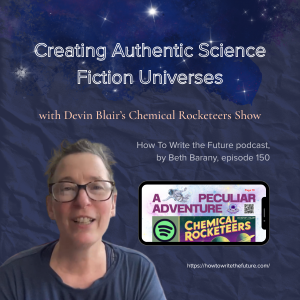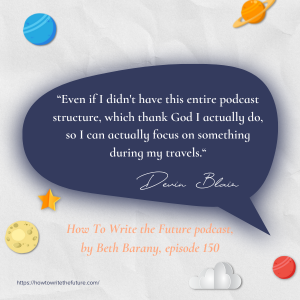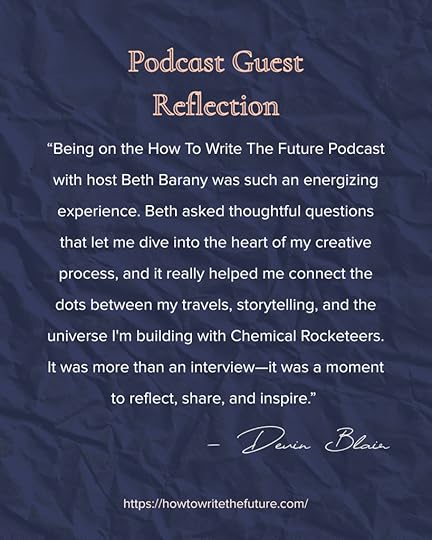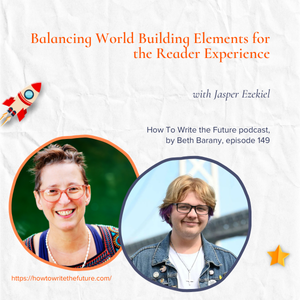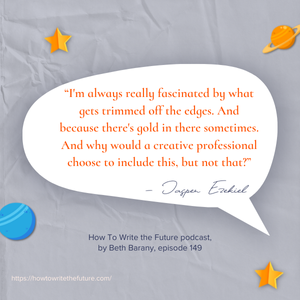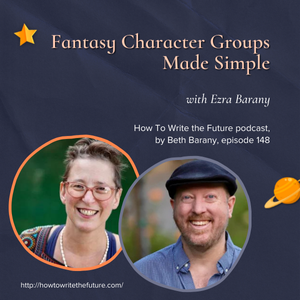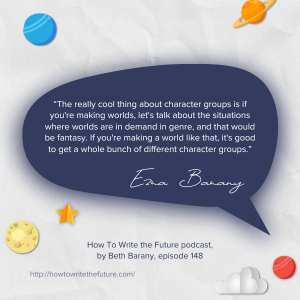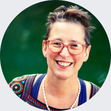Beth Barany's Blog, page 8
May 2, 2025
Meeting Your Heroes by Catharine Bramkamp
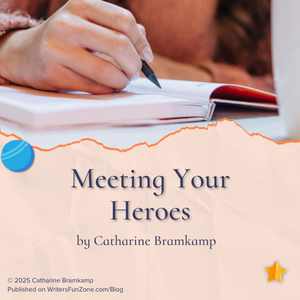 Let’s welcome back monthly columnist Catharine Bramkamp as she shares with us “Meeting Your Heroes.” Enjoy!
Let’s welcome back monthly columnist Catharine Bramkamp as she shares with us “Meeting Your Heroes.” Enjoy!
***
Conferences, book readings, workshops. All good for writing inspiration and a chance to meet the keynote speaker whose work you’ve been following for years.
Avid readers are fangirls, secretly or overtly, and there is nothing more thrilling than meeting our favorite authors face to face. SHE’S speaking? I have all her books; I would love to meet her!
“Listen, don’t meet your heroes. If you meet your heroes, you’re always going to be disappointed.” ― James McBride
No, no, you cry, surely my favorite author is exactly like the heroines in her books!
Surely she will inspire, of course she will deliver deep thoughts about her process, naturally she will be as funny in person as she is on the page.
Sometimes she is. Sometimes, not.
I am a huge fangirl of Natalie Goldberg, she of Writing Down the Bones.
Her books changed my life to the point I wrote a master’s thesis on her oeuvre and continue to collect her books to this day.
Meeting Your HeroesA year after I completed my MA, Goldberg was appearing at Book Passages in Marin.
Perhaps Zen Buddhism and public speaking are incompatible skills.
Goldberg is famous on the page, but a personality she is not. She is introverted, quirky and of course freaking brilliant, but not necessarily on demand.
I wasn’t disappointed, I had read all her work, I knew her quirks and abilities because she writes so honestly about them.
The contrast between how well she shares on the page, and her public reticence was less disappointing and more just interesting. She is fully human.
We all are.
Some authors are naturally charming, and Toastmasters trained.
They can give a good talk; they can interact with the audience in a genuine way – like Grant Faulkner or Brooke Warner.
Others like Eric Maisel, have their comfortable, memorized public talk, deliver it – walk away.
On paper, Maisel is marvelous and is quite engaging through his work and workshops.
But in real life? Maybe not so much.
That said, we don’t sign up to be authors because we are unrepentant extroverts, quite the opposite, we are solitary creatures happy to communicate from a distance, not happy one on one.
Which is why, when we meet our favorite authors out in the wild, we need to remember the nature of their species.
The Extroverted and the Introverted AuthorAuthors sometimes live the lives they record.
Some really do wander around the cliffs of Scotland, feeling, experiencing and engaging perfect strangers at the pub.
Others just brilliantly imagine wandering, feeling, and at some point they promise to engage with strangers. But not tonight.
As authors we can learn to present our work, or not.
Maybe we just want to work in the background and ask our niece to post on our Facebook account and we’re done.
I know authors who are very pleased to have sent six newsletters, two Instagram posts, and zero public appearances.
Your favorite author may be terrified of box jellyfish, Golden Retrievers and public speaking. Many of us are.
When you encounter a favorite author, thank them for showing up.
Thank them for hours of entertainment or life changing advice.
Then step away, don’t crowd them, they need a lot of oxygen.
I had a chance to meet one of my favorite dance choreographers.
I was thrilled I could meet and shake hands with a genius.
His development director warned me that he did not suffer inane comments gladly, probably because he has spent too many hours listening to the same gushing comments from audience members, his feet hurt, and he’s tired of smiling.
Forewarned is forearmedWhen it was my turn (we all stood in a reception line of sorts, so the poor man could get it all over with in as efficient manner as possible) I shook his hand and thanked him for years of inspirational art. That’s it.
He smiled, I smiled. I’m happy, he forgot me a minute later.
Every artist is allowed to play to their strengths.
If your favorite author turns out to be engaging and funny and delivers a fabulous TED Talk and looks at you warmly as you struggle for words to express how much you admire them, you have a win.
If your favorite author comes across as a little less than stellar, you can assure yourself that you did a better job presenting to the Gold Country Rotary Club.
Which means you too can discuss your book in public because the bar is apparently lower than you thought.
Win win, but in an unexpected way.
Need your help! I’m writing a book on creativity and I need your input. Please take this quick survey and your story may be featured! Due July 1, 2025
***
Want to read more articles like this one Writer’s Fun Zone? Subscribe here.
***
ABOUT THE AUTHOR Catharine Bramkamp is a successful writing coach, Chief Storytelling Officer, former co-producer of Newbie Writers Podcast, and author of a dozen books including the Real Estate Diva Mysteries series, and The Future Girls series. She holds two degrees in English and is an adjunct university professor. After fracturing her wrist, she has figured out there is very little she is able to do with one hand tied behind her back. She delights in inspiring her readers.
Catharine Bramkamp is a successful writing coach, Chief Storytelling Officer, former co-producer of Newbie Writers Podcast, and author of a dozen books including the Real Estate Diva Mysteries series, and The Future Girls series. She holds two degrees in English and is an adjunct university professor. After fracturing her wrist, she has figured out there is very little she is able to do with one hand tied behind her back. She delights in inspiring her readers.
The post Meeting Your Heroes by Catharine Bramkamp appeared first on Writer's Fun Zone.
April 28, 2025
Creating Authentic Science Fiction Universes with Devin Blair’s Chemical Rocketeers Show
Creating Authentic Science Fiction Universes with Devin Blair’s Chemical Rocketeers Show – How To Write the Future podcast, episode 150
***
“Even if I didn’t have this entire podcast structure, which thank God I actually do, so I can actually focus on something during my travels.“ – Devin Blair
In this episode of How To Write the Future, host Beth Barany talks to Devin Blair, the creator of the sci-fi podcast Chemical Rocketeers. Together they discuss Devin’s current adventures in Afghanistan and why traveling is everything to him. They also share the challenges in world building and the influence travel can have on your creativity.
“Being on the How To Write The Future Podcast with host Beth Barany was such an energizing experience. Beth asked thoughtful questions that let me dive into the heart of my creative process, and it really helped me connect the dots between my travels, storytelling, and the universe I’m building with Chemical Rocketeers. It was more than an interview—it was a moment to reflect, share, and inspire.” — Devin Blair
Platforms The podcast is available on Apple Podcasts | Buzzsprout | Spotify | Podcast Addict | Amazon Music| YouTube
RESOURCESGET HELP WITH YOUR WORLD BUILDING – START HERE
Free World Building Workbook for Fiction Writers: https://writersfunzone.com/blog/world-building-resources/
Sign up for the 30-minute Story Success Clinic with Beth Barany: https://writersfunzone.com/blog/story-success-clinic/
Get support for your fiction writing by a novelist and writing teacher and coach. Schedule an exploratory call here and see if Beth can support you today: https://writersfunzone.com/blog/discovery-call/
About the How To Write the Future podcastThe How To Write The Future podcast is for science fiction and fantasy writers who want to write positive futures and successfully bring those stories out into the marketplace. Hosted by Beth Barany, science fiction novelist and creativity coach for writers. We cover tips for fiction writers. This podcast is for readers too if you’re at all curious about the future of humanity.
This podcast is for you if you have questions like:
– How do I create a believable world for my science fiction story?
– How do I figure out what’s not working if my story feels flat?
– How do I make my story more interesting and alive?
This podcast is for readers too if you’re at all curious about the future of humanity.
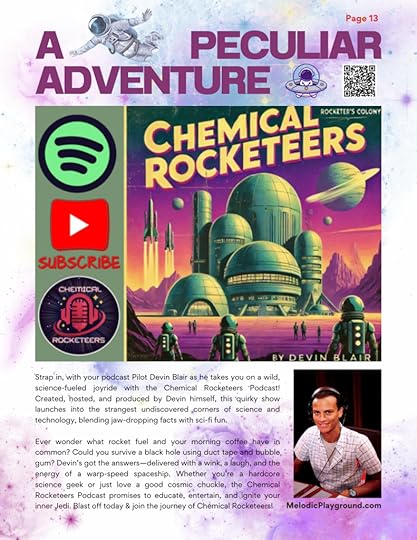
Devin Blair is the creator of Chemical Rocketeers, a sci-fi podcast that blends immersive storytelling, real-world inspirations, and futuristic themes of exploration, survival, and emergence. Drawing from his travels and background in Chemical Engineering Technology, Devin crafts a richly detailed universe where factions battle for survival, technology meets mysticism, and history shapes the future. Through podcasting, field reports, and multimedia storytelling, he builds an ever-expanding sci-fi universe that connects with fans on multiple levels.
LinkTree: https://linktr.ee/chemicalrocketeers101
Facebook: https://www.facebook.com/profile.php?id=61566804364795
Instagram: https://www.instagram.com/chemicalrocketeers101/
LinkedIn: https://www.linkedin.com/in/devin-blair-8a625a206
YouTube: http://www.youtube.com/@ChemicalRocketeers
Transcript for Creating Authentic Science Fiction Universes with Devin Blair’s Chemical Rocketeers Show [00:00] IntroductionWelcome to How to Write the Future Podcast. I’m your host, Beth Barany. I’m an award-winning science fiction and fantasy writer. Also a creativity coach, book editor, book consultant, and oh yeah, what else? Filmmaker. More about that later.
[00:16] Guest Introduction: Devin BlairSo today, really excited to bring with you a multi-passionate, multi-talented creative: Devin Blair.
Devin is coming into the recording today from Afghanistan. Devin Blair is the creator of Chemical Rocketeers, a sci-fi podcast that blends immersive storytelling, real world inspirations and futuristic themes of exploration, survival, and emergence. Drawing from his travels and background in chemical engineering technology, Devin crafts a richly detailed universe where factions battle for survival technology meets mysticism and history shapes the future. Through podcasting field reports and multimedia storytelling, he builds an ever expanding sci-fi universe that connects with fans on multiple levels.
Welcome Devin. I’m so excited to have you here. Really interesting project that you’re up to. Welcome.
An honor and pleasure. Thank you so much for having me on the platform.
[01:21] Devin’s Current Adventures in AfghanistanReally glad you’re here. And as we were getting organized, everyone, for this interview, you were emailing me from Dubai, and now you’re in Afghanistan. [01:31] Traveling and World BuildingCan I ask what is it that you’re doing? Are you just traveling, sightseeing, visiting friends, doing work? What are you up to?
Yes, that’s actually a really good question. I was actually formally invited when I was actually networking around, Dubai to find a way to have my best tour going around for Afghanistan. ’cause Afghanistan’s not really a place that you just go and solo tour unless you actually know places but I actually hit up a group that tours for Afghanistan. and so I hit them up and then I had my visa and letter of invitation made up while I was in Dubai.
And so now I’m in Afghanistan at the guest house, getting ready for my tour for this week.
That’s quite an opportunity. Alright, let’s dive into our interview.
[02:10] Challenges in World-BuildingCan you tell me what are some of the key challenges in building a post-apocalyptic yet hopeful future, in fiction?
Yes. So basically balancing the grit with growth and having to show the damage, but also the drive to rebuild, which actually takes the Rocketeers, colony where they actually have to rebuild humanity. And in the Rocketeers universe, it’s also trying to show you even in the ruins, the unity and curiosity as the mission becomes bigger than survival itself. ‘Cause this is basically the upbringing of humanity trying to be rebuilt. They go explore. It’s not even just about loss, it’s also what could be created next.
So, it, the audio is a little bit choppy .There’s some kind of apocalypse that has happened and humanity is trying to rebuild?
Yeah, so the story goes on planet Earth. Basically there’s a nuclear catastrophic event happens, and right before it does happen, the secret organizations on the governments, which I haven’t fully explained just yet, which I’m still working the story out for seasons, which it will be further explained in the future seasons, they basically sent this colony that’s selected by the organizations to a distant planet to rebuild humanity, and they have to start from scratch from there.
Okay, cool.
[03:23] Influence of Travel on CreativityAnd so how does traveling really influence your approach to world building and character development?
Even if I didn’t have this entire podcast structure, which thank God I actually do, so I can actually focus on something during my travels. But it even comes with different cultures and everything else. even just redefine your character and actually making you more well deserved, so basically traveling is everything for me when I’m actually pursuing this project. And for every country, for every person I meet it can actually find me some elements. I can actually find ways to write my characters. You know, it makes them more feel real. Sometimes it can be an event, sometimes it can be a location and a culture experience. It just really sparks something. It’s like a festival throughout event or even throughout the country itself. Even exploring the ruins in Italy could shape up a mission setting or how I can pull elements from each country and a visit and mixing the right ingredients based on culture history.
That’s a big one. History. The vibe check even settle out to build factions, characters, environments, it’s all about balancing one with another while staying consistent in my world building.
Yeah, consistency is key. And you emphasized in your bio, you emphasized history and now again you emphasize history. Tell me more about how history is helping you shape your story.
This actually comes from a future episode that I don’t wanna spoil too much because it hasn’t been released yet because it’s still in the production. But this takes about back in like World War I, where we actually talk about the technology of the uprising and all that kind of stuff.
And that can actually spark an interest in one of the countries I’ve been through. So take for example, throughout Europe where they had the crusaders but it also takes from the technology and just mixing up the right ingredients from a faction that can be built from the Crusaders and they can be built into World War I technology. Yeah, I totally understand. And especially that time period is very, very rich, in terms of inspiration.
So what advice do you have for aspiring science fiction and fantasy writers who are trying to create immersive universes?
Yes, that is a very important question. It’s not even an answer for everyone because maybe not everyone has that kind of opportunity, because you can have a really big idea for your case and ideas can be very important, there’s kind of two biggest pillars.
You have to create something lasting authentic consistency. And you can have a strong vision of what you’re building.
It’s more like focusing on something that feels to you laying down a solid foundation from a core theme to world logic and tone and growing it piece by piece.
More like a slow and steady race ’cause I mean, it’s not really like a race to get to because something your life’s passion. You keep track of everything, stay present in the creative flow and commit to showing up very regularly.
That’s how immersive universe stays strong.
[06:04] Engaging the Audience Beyond StorytellingReally fun. Can you share some insights on how you’re engaging your audience beyond just storytelling? You mentioned branding, interactive content, or other ways that you are engaging with your audience beyond the podcast itself.
Yes, that is another great question for that case. It has actually leaned into, number four, which actually for me, it’s about crafting a full circle experience rooted in- we talked about the two pillars about consistency and being authentic. I didn’t wanna like butcher the word ’cause sometimes I could be a little struggling about that. It’s actually collaborating, networking, and showcasing the work on my different platforms so people can hear and see it and feel the Rocketeers’ universe. ‘Cause even for the two platforms I use the most for my work is Facebook and Instagram, which is for the art and the written storytelling while YouTube and Spotify and similar podcast, platforms are more audio experiences where you hear the main episodes. So when you hear about season one and the main episodes,and when you actually read the reports on Facebook and when you read the field reports, those are actually the side missions. I actually explained the lore between season one and season two. And the goal is to make it feel like you’re stepping right into the action. Like you’re actually watching, you watch your favorite movie like Indiana Jones and you’re like, oh, snap, I’m actually, it feels like I’m in there. Or it feels like I’m actually getting bull whipped by Indiana Jones himself. You know what I mean? And like each piece just feels like it’s flowing to the next and building something bigger together.
I really love that because, for myself as a writer, I write reports, telegrams, telegraphs, phone conversations, memos, sayings, quotes. But a lot of that exists in backstory. And then I use some of it in the fiction, in the novels that I make, and now I’m moving into filmmaking and television and I’m also developing those kinds of things.
And that’s very inspiring to remember to use– some people call it interstitial material– that doesn’t necessarily end up in what we consider the final product, but actually is fabulous for interacting with our audience. So really, really fun that you’re doing that.
[08:07] Devin’s Background and Career ShiftGive us a plug for where we can find Chemical Rocketeers.
Oh yeah, you can basically find anywhere you can search Chemical Rocketeers and boom, there you go.
Excellent. And I’ll be sure to put all those links in our show notes, which will be on our blog, YouTube, all the podcast outlets, and then we market all over the socials, so we’ll definitely be spreading the word for you.
[08:29] Final Thoughts and FarewellIs there anything else that you would like our audience to know? And our audience are mostly writers, science fiction and fantasy writers.
Anything that you’d like them to keep in mind as, as a parting thought?
If there’s probably one more thing I can add into it, it’s probably always had a cross collab with other people and all that kind of stuff because it can actually- with two sparking minds, it can actually make a lot more, better ground.
Yeah. Cross collaboration. That’s wonderful. That’s so great. Well, Devin, I wanna thank you so much for taking your time and your world travels so awesome. I’m saying hello to you from the San Francisco Bay Area, and you’re all the way there in Afghanistan. Stay safe and thank you so much for being on How To Write The Future.
It’s an honor. Thank you so much.
All right everyone. That’s it for this week. Write long and prosper.
Devin Blair Podcast ReflectionLoved this episode? Leave us a review and rating here: https://www.buzzsprout.com/2012061Need instructions on how to leave a review? Go here.
***ABOUT BETH BARANYBeth Barany teaches science fiction and fantasy novelists how to write, edit, and publish their books as a coach, teacher, consultant, and developmental editor. She’s an award-winning fantasy and science fiction novelist and runs the podcast, “How To Write The Future.”
Learn more about Beth Barany at these sites:
Author site / Coaching site / School of Fiction / Writer’s Fun Zone blog
CONNECTContact Beth: https://writersfunzone.com/blog/podcast/#tve-jump-185b4422580
Email: beth@bethbarany.com
LinkedIn:https://www.linkedin.com/in/bethbarany/
IG: https://www.instagram.com/bethbarany/
TT: https://www.tiktok.com/@bethbarany/
FB: https://www.facebook.com/bethbarany
X: https://twitter.com/BethBarany
CREDITS EDITED WITH DESCRIPT: https://www.descript.com?lmref=_w1WCA (Refer-a-Friend link)MUSIC CREDITS : Music from Uppbeat (free for Creators!): https://uppbeat.io/t/soundroll/fuzz-buzz License code: UMMKDRL02DFGKJ0L. “Fuzz buzz” by Soundroll. Commercial license: https://musicvine.com/track/soundroll/fuzz-buzz.DISTRIBUTED BY BUZZSPROUT: https://www.buzzsprout.com/?referrer_id=1994465 (Refer-a-Friend link)SHOW PRODUCTION BY Beth BaranySHOW CO-PRODUCTION + NOTES by Kerry-Ann McDadeC 2025 BETH BARANY
For more “How To Write the Future” episodes, go here.
If you’d like to invite Beth onto your podcast, drop her a note here.
 Like the work we do? Tip us! https://ko-fi.com/bethbarany
Like the work we do? Tip us! https://ko-fi.com/bethbarany
The post Creating Authentic Science Fiction Universes with Devin Blair’s Chemical Rocketeers Show appeared first on Writer's Fun Zone.
April 25, 2025
Boost Your Creative Writing Motivation with Dr. Maisel’s Purpose-Driven Approach by LA Bourgeois
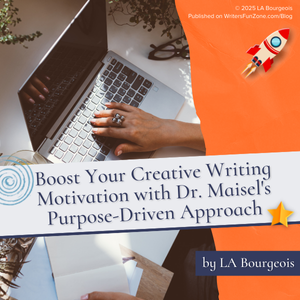 Let’s welcome back LA Bourgeois as she shares with us “Boost Your Creative Writing Motivation with Dr. Maisel’s Purpose-Driven Approach.” Enjoy!
Let’s welcome back LA Bourgeois as she shares with us “Boost Your Creative Writing Motivation with Dr. Maisel’s Purpose-Driven Approach.” Enjoy!
***
Dr. Eric Maisel doesn’t seem like a man who can get bored.
“I’m just endlessly curious about human nature,” he says. “I find it easy to move from one project, area or idea to the next. I’ve been doing that for a long time.”
And his new book, Choose Your Life Purposes, promotes all of us to embrace this same wellspring of curiosity as we follow his system to create a dynamic set of life purposes to embody.
Choose Your Life Purposes leads us through bite-sized steps to find our own multiple life purposes and embrace them to become more self-aware and empowered.
Dr. Maisel proposes that by choosing and embracing our life purposes, we can live fully even as meaning flows in and out of our existence.
“It just seemed like a trap to believe that there was one purpose to life,” he says. “Once you get there, then it seems to be obvious that many things are important to us. And I’m turning those many things important to us into the idea of multiple life purposes.”
Dr. Maisel masterfully guides us through this process of defining our life purposes with lists, points of contemplation, and imaginative ways to keep your selected life purposes at the forefront of your mind.
One of the biggest differences between Maisel’s work and that of many authors who talk about “life purpose” is the rejection of the idea of doing “what you are meant to do” by a divine presence. Rather, he returns agency to us.
We are the ones deciding, choosing our life purposes rather than finding them and making meaning rather that discovering it.
This contemplation emphasizes self-awareness and empowerment to bring about a life filled with purpose aligned with our values.
As the song says, “Who could ask for anything more?”
Well, us, of course, because humans are greedy creatures. But from the very beginning of the process, I can feel how this system will help me create and support my own unique definition of a good life.
Dr. Maisel joined me to chat about how curiosity informs this process, and how meaning is different from life purposes.
What benefits does discovering your multiple life purposes deliver?Well, we’ve got to connect it up with that other word that is so difficult for people to understand, and that’s meaning.
They get lumped together as a phrase, life purpose and meaning, but they’re completely different things.
From my point of view, life purposes are choices and meaning is a psychological experience. It’s merely a certain kind of experience, nothing bigger than that.
We don’t like the experience of meaninglessness, but it’s merely a psychological experience. It’s not about some objective reality.
You might attend a lecture and one person has a meaningful experience, another person is completely bored. It has nothing to do with the lecture. It has to do with the experience of it.
We need that second paradigm shift from seeking meaning to making meaning, and the related idea that our life purposes are more important than our meaning-making activities.
If we’re doing what’s important to us and we don’t get the experience of meaning from it, that has to be okay.
It’s like doing something and hoping we’ll feel joyful. Well, we may not. It may be that sending out 20 emails in support of a cause didn’t make us feel joyful, but they were still the right thing to do.
People are checking in on that meaning thing rather than focusing on just doing the work of their life purposes. Meaning comes and goes.
There’s no reason why life should feel meaningful all the time any more than it should feel joyful all the time.
When people feel that life is meaningless, they don’t know what that means or what to do.
They don’t understand how trivial it is that it’s feeling meaningless.
If they can turn away from that worry about why isn’t life feeling meaningful to the realization that just living their life purposes is sufficient, that’ll do the job.
That’s a transformative shift, to go from feeling to doing.The difference is, if you live your life purposes, that doesn’t mean that life will feel purposeful.
Attaching to a certain outcome harms people.
If we understand what’s important to do, we have to let go of craving a feeling from doing it. We’re getting a result from doing it.
If I’ve helped a child today and written 3,000 words on my novel and worked in the garden, that’s a perfect day, irrespective of how it all felt.
That’s the day of my choice.
That’s the day of my dream. And if I’m also not happy, too bad.
How does curiosity deepen this process?We’re born with an appetite for knowing, and that’s squashed in many people by what goes on in school, at the dinner table, at their religious functions and what have you.
Every five year old is curious and creative.
If you ask them to connect a salmon and a skyscraper, they’ll draw you a salmon-shaped skyscraper, a skyscraper-shaped salmon, or they’ll just have fun with it.
The second they get into school and have to draw inside the lines, they need more information than that. They need to know what’s the right answer to the salmon-shaped skyscraper.
We begin to lose our imagination over time.
Curiosity is innate and natural, and gets lost and has to be reclaimed.
That’s one of the jobs of a creativity coach, to invite clients to be imaginative again and to break free of those lines that they were forced to draw within all through school.
***
Haven’t read Choose Your Life Purposes yet? Grab a copy today and embark on your own journey!
Our next book in the Thriving Creative Book Series is Jane Friedman’s The Business of Being a Writer, 2nd Edition, which was released this past April. Pick up a copy at your local independent bookshop or library (or order online) and begin reading today.
Need tips on finishing those pesky craft books? Read How to Finish Reading A Book . And for those who want to make sure they learn those lessons, check out How to Remember What You Read !
***
ABOUT LA BOURGEOIS LA (as in tra-la-la) Bourgeois is a Kaizen-Muse Certified Creativity Coach and author who helps clients embrace the joy of their creative work and thrive while doing it.
LA (as in tra-la-la) Bourgeois is a Kaizen-Muse Certified Creativity Coach and author who helps clients embrace the joy of their creative work and thrive while doing it.
Get more of her creativity ideas and techniques by subscribing to her newsletter at https://subscribepage.io/unlockyourcreativity.
The post Boost Your Creative Writing Motivation with Dr. Maisel’s Purpose-Driven Approach by LA Bourgeois appeared first on Writer's Fun Zone.
April 22, 2025
Can AI Content Be Copyrighted? by Kelley Way
 Let’s welcome back monthly columnist Kelley Way as she shares with us “Can AI Content Be Copyrighted?” Enjoy!
Let’s welcome back monthly columnist Kelley Way as she shares with us “Can AI Content Be Copyrighted?” Enjoy!
***
On January 29, 2025, the Copyright Office released its report on whether and when AI-generated content can be copyrighted.
While the results were consistent with its previous holdings on the copyrightability of AI content, they did provide some clarity on their reasoning and when AI-generated content may be granted copyright protection.
The VerdictAs a general rule, content created by an AI program cannot be copyrighted.
The Copyright Office has a longstanding rule that only creative works authored by humans can get copyright protection – photographs taken by the Hubble telescope and paintings made by elephants are examples of other creations that fail to meet the human authorship requirement.
So when an AI program provides the creative elements, the Copyright Office will deny copyright protection.
Their ReasoningAs to their reasoning, most AI-generated works are created from prompts provided by humans.
The Copyright Office compares this to someone instructing an artist to create a painting and then trying to claim authorship or joint authorship with the painter.
In most cases, this won’t fly because the instructions are simply ideas, and the painter is the one who supplies the creative elements.
While it’s possible that the prompt is so detailed there are no creative elements left for the AI program to fill in, it’s unlikely a person would take the time and effort to create such a prompt — at that point, you may as well do it yourself.
In addition, the output from these AI programs is currently extremely unpredictable; the same prompt can generate different outputs every time it’s entered.
In the Copyright Office’s opinion, this shows the user lacks sufficient control to be considered an author of the resulting work.
The Gray AreaOf course, there is still a gray area where a work contains content from both a human and an AI program.
In this situation, the question is whether AI acts as a tool to assist the human, or whether it acts as a substitute for human creativity.
The Copyright Office says it will decide this question on a case by case basis.
For example, a human may feed an image into an AI program and tell the program to make certain modifications.
If the modifications are specific enough that the AI is not providing creative expression, the entire result could get copyright protection.
If the AI program does provide creative expression, then the AI program’s contribution won’t get protection, but the human authored content will.
The same rule applies when a human modifies content generated by an AI program.
The selection and arrangement of the content can get copyright protection, as can any artistic modifications the human makes to the content.
Anything created by the AI program is still not protected.
The Copyright Office covered other related topics, such as how this question is being addressed in other countries, but the summary above is the information most relevant to American creatives. If you have questions or would like additional guidance, you can reach me at kaway@kawaylaw.com.
***
Want to read more articles like this one Writer’s Fun Zone? Subscribe here.
***
ABOUT THE AUTHORKelley Way was born and raised in Walnut Creek, California. She graduated from UC Davis with a B.A. in English, followed by a Juris Doctorate. Kelley is a member of the California Bar, and an aspiring writer of young adult fantasy novels. More information at kawaylaw.com.
The post Can AI Content Be Copyrighted? by Kelley Way appeared first on Writer's Fun Zone.
April 21, 2025
Balancing World Building Elements for the Reader Experience with Jasper Ezekiel
Balancing World Building Elements for the Reader Experience with Jasper Ezekiel – How To Write the Future podcast, episode 149
***
“I’m always really fascinated by what gets trimmed off the edges. And because there’s gold in there sometimes. And why would a creative professional choose to include this, but not that?” – Jasper Ezekiel
In this How To Write the Future episode, host Beth Barany chats with speculative fiction writer Jasper Ezekiel, and talks about what parts of our story worlds we include in our fiction and what gets left out including balancing story elements for the reader experience.
Platforms The podcast is available on Apple Podcasts | Buzzsprout | Spotify | Podcast Addict | Amazon Music| YouTube
RESOURCES
GET HELP WITH YOUR WORLD BUILDING – START HERE
Free World Building Workbook for Fiction Writers: https://writersfunzone.com/blog/world-building-resources/
Sign up for the 30-minute Story Success Clinic with Beth Barany: https://writersfunzone.com/blog/story-success-clinic/
Get support for your fiction writing by a novelist and writing teacher and coach. Schedule an exploratory call here and see if Beth can support you today: https://writersfunzone.com/blog/discovery-call/
About the How To Write the Future podcastThe How To Write The Future podcast is for science fiction and fantasy writers who want to write positive futures and successfully bring those stories out into the marketplace. Hosted by Beth Barany, science fiction novelist and creativity coach for writers. We cover tips for fiction writers. This podcast is for readers too if you’re at all curious about the future of humanity.
This podcast is for you if you have questions like:
– How do I create a believable world for my science fiction story?
– How do I figure out what’s not working if my story feels flat?
– How do I make my story more interesting and alive?
This podcast is for readers too if you’re at all curious about the future of humanity.
About Jasper EzekielJasper Ezekiel is a queer author from the SF Bay Area. He’s a jack of all trades, writing poetry, non-fiction, fiction, and plays. He’s also a visual artist who specializes in illustration, a fiber artist with dreams of being a pattern creator, and a big ol’ goofball. His first book of poetry, Good, Clean Mania was published in 2023. You can find it on multiple platforms here: https://books2read.com/u/3Gp5gO
Social media links:
Instagram: https://www.instagram.com/s8nicangel/
My personal Substack: https://jasperezekiel.substack.com/
My writing Substack: https://jasperezekielk.substack.com/
Transcript for Balancing World Building Elements for the Reader Experience with Jasper Ezekiel
Hi everyone. Welcome to How To Write the Future. I’m your host, Beth Barany, and I have a special episode for you today. My episodes are primarily for science fiction and fantasy writers, so today you’re gonna listen in on a conversation that I have with speculative fiction writer Jasper Ezekiel, and talking about what parts of our story worlds do we include in our fiction and what gets left out.
Enjoy.
[00:26] Introduction to World Building ChallengesI actually have another kind of concept I want to throw at you that has to do with world building, which is: How much work do we do on things that may or may not be included?
So one of the things I’ve always really struggled with world building is finding what is relevant to the world and what is just not because when building a world, it’s really easy to just go out and out and build these like complicated spider webs basically.
How do you make the decision on what to choose to build for your world?
That’s a great question.
[01:04] Incorporating Feedback and Intuition in WritingI have thoughts. I’m a very intuitive writer. So in my early drafts, I’m just putting in whatever occurs to me. When I’m editing and I have no answer to the question that critique partners and beta readers ask me, I write backstory. Then I come back into the manuscript and I try something.
I wrote some backstory. And then I ask that very same question: What is relevant to the story right now?
And then I make a guess and I put something in that feels right. Feelings, very intuitive. Then I put it in and then I send it back out to the beta readers and critique partners and see how they respond.
[01:43] Balancing Story Elements and Reader EngagementAnd it is also like: What is going to move the story forward? So I can talk more about that and, if you have any specifics that you want to share or I can just use examples from my own writing. Because I can tell you, I have 50,000 words worth of backstory on a book that’s 150,000 words that isn’t in the book.
Yeah. That’s one of the things that’s always really fascinated me about the creative process is like deleted scenes in movies. I’ve been watching a lot of Will Ferrell movies, and in the end they always show the bloopers and when they’re riffing on jokes, how they do the joke over and over in different ways.
And so it’s here’s the versions of the joke that didn’t make it in the movie. I’m always really fascinated by what gets trimmed off the edges. And because there’s gold in there sometimes. And why would a creative professional choose to include this, but not that?
Is it their decision? Is it their audience’s decision? Is it in a movie’s case, the director or the producer’s decision? It’s really interesting to me.
Yeah, that is fascinating.
[02:46] The Editing Process and Reader ExperienceI think we start to get into the real nitty gritty as someone who’s edited a ton of other people’s work as well as my own work, it’s again, I come back to this kinesthetic sense of is the energy going upward or is the energy like plunk?
Does it just stop, ’cause the reader experience, we want it to have this forward movement. And I even noticed it when as I start to give direction on editing my short film. I can feel oh, we’re moving, and then things stop. Oh, we’re moving things. So we don’t ever want a stop in our story.
We want it always to be feeling like things are moving forward, even in quiet moments, even when there’s no action or no dialogue. So that’s my barometer, personal barometer. And I also have readers here for X experience. Does what I have on the page match that experience?
So I’ve made a decision about what that X experience is, and it, again, it’s a feeling.
I’ll often say in the past, a compelling read. I’m like, wow. It’s always a compelling read, no matter the book. And in this book it’s often: How do I keep people engaged, moving forward and invested, emotionally caring? So anything that hinders that, stops that, interrupts that, gets cut.
Even if I’ve labored over it for hours and days and years. Cause at the end of the day, it’s this overall experience we’re creating.
[04:06] Finalizing the Manuscript and TestingAnd then I test it. That’s what the beta readers are for, and the critique partners. And then I do another read, have people, hopefully strangers who haven’t yet read the book, also read the book toward the end before I publish to make sure everything is happy. Like the only critique they might have is, I am so angry at your villain. I’m like–
Yeah,That’s a good one to get. I would feel really pleased if somebody said that to me.
Or, oh, I was so rooting for her and, Ooh, I really love your secondary character. Can she have her own story?
And I’m like-
Yes.
Now they’re invested. Now there’s nothing about the craft. No spelling errors, no egregious typos stopping them and. Yeah. And I also am measuring that as I, in this stage with the beta readers, ’cause I’m in final phase now and I’m paying attention to what my beta readers go, oh, I think you need a glossary.
Or, I didn’t know what these Spanish words meant. And I’m like, okay, yeah I am presupposing people have some Spanish under their belt.
Yeah.
I need to deal with that somehow. And It’s a lot of testing. A lot of testing. Yeah. I know they do that with film. And I’ll be doing that with my film and with TV. They probably have a lot of experienced cooks in the kitchen helping with the same thing.
[05:15] Invitation and ClosingThat’s it for this week everyone. If you have any questions or you would like to get your question answered live in an episode, be sure to check out our Story Success Clinic where you can sign up and we can have a conversation that we share with the world and you can get some live coaching.
So be sure to contact me through the podcast, how to write the future.com.
That’s it for this week, everyone. Write long and prosper.
Loved this episode? Leave us a review and rating here: https://www.buzzsprout.com/2012061Need instructions on how to leave a review? Go here.
***ABOUT BETH BARANYBeth Barany teaches science fiction and fantasy novelists how to write, edit, and publish their books as a coach, teacher, consultant, and developmental editor. She’s an award-winning fantasy and science fiction novelist and runs the podcast, “How To Write The Future.”
Learn more about Beth Barany at these sites:
Author site / Coaching site / School of Fiction / Writer’s Fun Zone blog
CONNECTContact Beth: https://writersfunzone.com/blog/podcast/#tve-jump-185b4422580
Email: beth@bethbarany.com
LinkedIn:https://www.linkedin.com/in/bethbarany/
IG: https://www.instagram.com/bethbarany/
TT: https://www.tiktok.com/@bethbarany/
FB: https://www.facebook.com/bethbarany
X: https://twitter.com/BethBarany
CREDITSEDITED WITH DESCRIPT: https://www.descript.com?lmref=_w1WCA (Refer-a-Friend link)MUSIC CREDITS : Music from Uppbeat (free for Creators!): https://uppbeat.io/t/soundroll/fuzz-buzz License code: UMMKDRL02DFGKJ0L. “Fuzz buzz” by Soundroll. Commercial license: https://musicvine.com/track/soundroll/fuzz-buzz.DISTRIBUTED BY BUZZSPROUT: https://www.buzzsprout.com/?referrer_id=1994465 (Refer-a-Friend link)SHOW PRODUCTION BY Beth BaranySHOW CO-PRODUCTION + NOTES by Kerry-Ann McDadeC 2025 BETH BARANY
For more “How To Write the Future” episodes, go here.
If you’d like to invite Beth onto your podcast, drop her a note here.
 Like the work we do? Tip us! https://ko-fi.com/bethbarany
Like the work we do? Tip us! https://ko-fi.com/bethbarany
The post Balancing World Building Elements for the Reader Experience with Jasper Ezekiel appeared first on Writer's Fun Zone.
April 18, 2025
Literary Tropes Are Like French Fries by Laurel Osterkamp
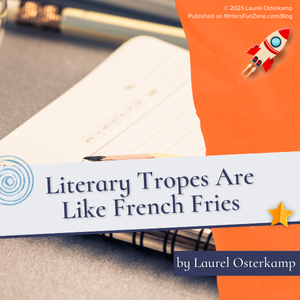 Let’s welcome back Laurel Osterkamp as she shares with us “Literary Tropes Are Like French Fries.” Enjoy!
Let’s welcome back Laurel Osterkamp as she shares with us “Literary Tropes Are Like French Fries.” Enjoy!
***
Literary tropes.
We know they are recurring patterns or themes in literature, serving as a shorthand for certain ideas or emotions.
But how do we use them to our advantage?
Think of it like this: literary tropes are like eating at McDonald’s.
You know exactly what you’re going to get.
Should you eat there everyday? Hell, no!
But sometimes it’s alright, especially if you’re in the mood for greasy, salty french fries.
Literary tropes are like McDonald’s french fries.
Readers will look at your novel and decide, “Yes, I know what I’m getting here and it’s exactly what I want.”
But, it’s easy to eat too many french fries and feel disgusting.
Am I right?
The trick is to use tropes as a vehicle to enhance your story.
Just make sure the tropes aren’t the story itself.
And if that’s unclear, here are some examples…
1. Use Tropes to Create Dynamic CharactersTropes such as “the hero’s journey” or “the chosen one” can give readers a sense of familiarity and help them connect with the protagonist on a deeper level.
For example, I’m in the middle of Sunshine on the Reaping, so I’ve got the Hunger Games books on my mind.
Suzanne Collins uses the hero’s journey and the idea of a “chosen one” with Katniss, and again in the prequel with Haymitch.
We know ahead of time that he’ll prevail in the games, that it’s his destiny to play a major part in the revolution.
Thus, his heroic character arc becomes more about the journey and less about the destination.
This adds complexity to his character, creating a sense of destiny and purpose for the reader to root for.
Similarly, the “anti-hero” trope, where the protagonist has questionable morals or motivations, can add depth and intrigue to a character.
In Patricia Highsmith’s Ripley series, Tom Ripley is a smooth, easy-going psychopath.
Nothing, not even murder, will stop Tom from getting what he wants.
And yet, there’s something likeable about Tom.
He has an underdog quality that causes the reader to root for him.
By using the anti-hero trope, Highsmith allows readers to see Tom’s journey from a different perspective, making him layered and complex.
2. Use Tropes to Add TwistsWhile tropes can be used to create familiarity and engage readers, they can also be subverted to add surprises and twists to the story.
Subverting tropes means taking a familiar pattern or theme and turning it on its head.
For example, many argue that Jane Austen’s classic, Pride and Prejudice, invented the “enemies to lovers” trope and established the model for a perfect Regency romance.
But those tropes are subverted in Seth Grahame Smith’s Pride, Prejudice, and Zombies, when he combines a rom-com of manners with a blood-soaked zombie tale.
The result was a fresh and unique twist to a familiar story.
3. Use Tropes for World-BuildingTropes can also be used to enhance the setting and world-building in a novel.
The “dystopian society” trope has been used in many popular books.
One not-so-recent example is Margaret Atwood’s The Handmaid’s Tale.
Atwood’s dystopian novel takes place in the Republic of Gilead, formerly the U.S.
There, a woman’s worth is determined by her baby-making abilities.
Atwood’s dystopia is set in the near-future, contrasting present-day with a horrific future nightmare.
4. Adding Humor and SatireTropes can also be used to add humor and satire to a novel. The “fish out of water” trope, where a character is placed in a situation or setting they are unfamiliar with, can create comical situations and add levity to a story.
In Allison Espach’s The Wedding People, the protagonist, Phoebe Stone shows up at a classy hotel intending to kill herself.
However, when it turns out that she’s the only guest who isn’t part of a week-long wedding, Phoebe is sucked into the events and bonds with the bride.
Her unfamiliarity turns what would be a depressing story into something both funny and uplifting.
Literary tropes can be powerful writing tools if you use them correctly.
Whether used to create dynamic characters, subvert expectations, build a world, or add humor, tropes can elevate a story and engage readers on a deeper level.
Just use them sparingly, and with intention.
Like a box of french fries from McDonald’s, tropes can be an incredibly appetizing treat.
As long as they’re not your main nutrition source, you’re doing great!
***
About the Author Laurel Osterkamp is from Minneapolis, where she teaches and writes like it’s going out of style. Her short fiction has been featured in Abandon Journal, Idle Ink, Tangled Locks Literary Journal, Bright Flash Literary Journal, and The Metawoker, among other places. Her new novel, The Side Project, was released on November 13th by The Wild Rose Press.
Laurel Osterkamp is from Minneapolis, where she teaches and writes like it’s going out of style. Her short fiction has been featured in Abandon Journal, Idle Ink, Tangled Locks Literary Journal, Bright Flash Literary Journal, and The Metawoker, among other places. Her new novel, The Side Project, was released on November 13th by The Wild Rose Press.
Follow her on Social Media:
Website – https://laurellit.com
Facebook – https://www.facebook.com/authorlaurelosterkamp
BookBub – https://www.bookbub.com/profile/laurel-osterkamp
Instagram: Laurel Osterkamp (@laurel_osterkamp) • Instagram photos and videos
The post Literary Tropes Are Like French Fries by Laurel Osterkamp appeared first on Writer's Fun Zone.
April 17, 2025
Author Interview with Matt Posner, The School of Fiction
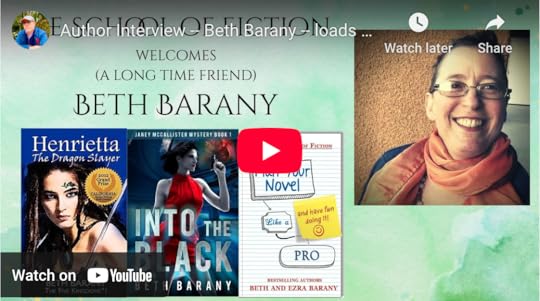 Enjoy this author interview I did with Matt Posner on his YouTube channel, The School of Fiction.
Enjoy this author interview I did with Matt Posner on his YouTube channel, The School of Fiction.
There’s loads of book marketing advice and good silliness.
Enjoy!
Resources mentioned in this interviewHeart-Centered Marketing for Fiction WritersWrite for Writers Fun ZoneDraft your Author Branding StatementABOUT MATT POSNER – THE SCHOOL OF FICTIONOn his voice:
Beginners and intermediate writers of fiction — I’m Matt, and I’m here to share my knowledge with you after more than forty years of studying and practicing the craft of fiction writing. Let’s work together to make you the fiction writer you want to be!
I’ll talk about all aspects of fiction writing, from plot to dialogue to characterization, setting to mood and tone to pacing, drafting to proofreading to editing, and yes, even ethical uses of AI language models. Ask me questions in the comments below.
Besides being a writer, I’m a teacher with more than twenty years of experience, a world traveler, a photographer, and a performer. I like museums, botanical gardens, comics, and nearly all genres of fiction, drama, and poetry.
The post Author Interview with Matt Posner, The School of Fiction appeared first on Writer's Fun Zone.
April 15, 2025
Collaborative Writing: Three Ways to Do It by Jasper Ezekiel
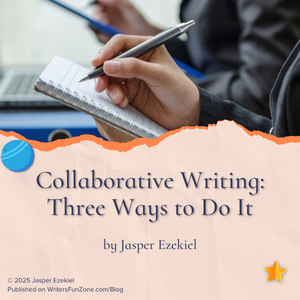 This week’s featured article is “Collaborative Writing: Three Ways to Do It by Jasper Ezekiel.” Enjoy!
This week’s featured article is “Collaborative Writing: Three Ways to Do It by Jasper Ezekiel.” Enjoy!
***
My husband and I write together more often than we go on dates.
Almost every day has a portion of it dedicated to working on our current stories.
This relationship model has helped us stay together through 2 years of East Coast-West Coast long distance, serious health issues (on both our part’s and the dogs’..)
Our collaborative writing is done in the style of 2000’s forums roleplays, something we both grew up doing, where I write a paragraph, then he writes a paragraph, but there are plenty of ways to write collaboratively. Here are a couple of ways that you can do it.
1. Paragraph RoleplaysParagraph roleplays are an excellent way to collaborate.
The process is pretty straightforward, in my opinion.
After talking as much or as little about the plot as you want, one of you writes a paragraph starting the story.
Each one of you “controls” one (or more) characters of your choosing and you keep your writing to the actions and inner thoughts of that character.
This works great for character driven stories, where the character gets to make all of the decisions and that’s how the plot is moved forward.
One thing to keep in mind about this style of collaborative writing is to be respectful of the other person’s character, to not overstep your power over them. In the forum world, this is called “godmodding,” referring to the term “mod” or short for moderator, the name of the writer behind the character.
On roleplay forums, the character you’re writing is called your “muse.”
For example, my muse is a character named Briar, who is an evil dictator of a fantasy world. My husband’s muse is Patrick, his right hand man. (We love to write dark stories about villains.)
2. Back and Forth ChaptersAnother way to collaboratively write is for one writer to write a chapter, then the next person to write the next chapter.
This style works well for both discovery plotting and having a pre-established plot that you’ve agreed on.
In this style, each writer has a little more control over all of the characters because the assumption is that both writers are making more decisions for each character due to the drawn out style of writing chapters rather than snappier paragraphs.
There are actually entire published novels in this style. One that I can think of is will grayson, will grayson by John Green and David Levithan.
Both authors write about two different young boys, both named Will Greyson, and about how their lives parallel and overlap as they go to the same high school.
This book was a great inspiration for me and my adventures in collaborative writing and when I was younger I wrote a book in this style with my best friend at the time.
3. The ConsultantThe final form of collaborative writing that I’d like to share works when your creative partner may have ideas but may not be a writer.
While my husband may be an avid roleplayer, he rarely writes in his own time, so when there’s a story I want to write with him, sometimes we work together on the backend and I draft it myself.
Our process generally goes like this:
We discuss the concept and the plot together. He gives me a bunch of ideas of scenes and dialogue and things his characters might do that I can write about.I write the first draft of the story on my own based on the notes I took from our discussion.I read it to him and we edit it together.I go over everything with a fine toothed comb for the final draft.Ta-dah!
Another collaborative project finished.
While he may not have been involved in the drafting process, his contributions to the important, nitty-gritty pieces of plot are vital to the success of our collaborative project.
I wrote an entire novel this way with him (still in the editing process, though!)
Which is Best?It’s hard to say which style of collaborative process is going to be best for you.
If you have a writing friend you’d like to try this out with, just send them a text asking!
While everyone says writing is a lonely process meant to be done hunched over a desk late at night with a pot of coffee, my best work has been done in the company and with the help of my friends and lovers.
Happy writing!
***
About The AuthorJasper Ezekiel is a poet and all around writer from the San Francisco Bay Area. He’s also an illustrator, a photographer, a fiber artist, a jokester and a huge dork. His book of poetry is called Good, Clean Mania and is available on several digital platforms, as well as in print through Amazon.
You can find him on Instagram @s8nicangel on substack
Good, Clean Mania is a collection of three zines that Jasper Ezekiel put together over the years of 2020-2022. These zines have been further edited into completion to be the book you hold in your hands today. Topics of Jasper’s poetry spans from things like God and love to a bad day at the hardware store to a connection with his cat right before she passed away.
https://books2read.com/u/mlxZ6A
The post Collaborative Writing: Three Ways to Do It by Jasper Ezekiel appeared first on Writer's Fun Zone.
April 14, 2025
Fantasy Character Groups Made Simple with Ezra Barany
Fantasy Character Groups Made Simple with Ezra Barany – How To Write the Future podcast, episode 148
***
“The really cool thing about character groups is if you’re making worlds, let’s talk about the situations where worlds are in demand in genre, and that would be fantasy. If you’re making a world like that, it’s good to get a whole bunch of different character groups.” – Ezra Barany
In this episode of How To Write the Future podcast, titled “Fantasy Character Groups Made Simple with Ezra Barany” host Beth Barany hands the mic over to her husband and fellow author Ezra Barany where he shares an introduction to creating character groups in fantasy words, exploring creating a religion and politics, giving you creative freedom in your story world. Beth Barany also shares a few of the ways she can help you with your world building from taking part in a free story success clinic to appearing on the show.
Platforms The podcast is available on Apple Podcasts | Buzzsprout | Spotify | Podcast Addict | Amazon Music| YouTube
RESOURCESGET HELP WITH YOUR WORLD BUILDING – START HERE
Free World Building Workbook for Fiction Writers: https://writersfunzone.com/blog/world-building-resources/
Sign up for the 30-minute Story Success Clinic with Beth Barany: https://writersfunzone.com/blog/story-success-clinic/
Get support for your fiction writing by a novelist and writing teacher and coach. Schedule an exploratory call here and see if Beth can support you today: https://writersfunzone.com/blog/discovery-call/
About the How To Write the Future podcastThe How To Write The Future podcast is for science fiction and fantasy writers who want to write positive futures and successfully bring those stories out into the marketplace. Hosted by Beth Barany, science fiction novelist and creativity coach for writers. We cover tips for fiction writers. This podcast is for readers too if you’re at all curious about the future of humanity.
This podcast is for you if you have questions like:
– How do I create a believable world for my science fiction story?
– How do I figure out what’s not working if my story feels flat?
– How do I make my story more interesting and alive?
This podcast is for readers too if you’re at all curious about the future of humanity.
ABOUT EZRA BARANYEzra Barany loves riveting readers with thrillers, but by order of the Department of Motor Vehicles he must place a warning on every book cover, “Do not read while driving.” His first two books in The Torah Codes series were award-winning international bestsellers. The second two books in the 4-book series wowed readers too! In his free time, he has eye-opening discussions on the art of writing novels with his wife and book coach Beth Barany. A high school physics teacher, Ezra lives in Oakland with his beloved wife and two cats working on the next book in The Torah Codes series. Ezra, not the cats. For a free short story in The Torah Codes series, “The Mourner’s Kaddish,” do please go to http://www.thetorahcodes.com/
Transcript for Fantasy Character Groups Made Simple with Ezra BaranyHey everyone. Beth Barany here with How to Write The Future Podcast. I am a science fiction and fantasy writer, writing teacher, creativity coach, podcaster, obviously, and filmmaker. I’m also married to another writer. so I have a special episode for you today. My husband, Ezra Barany, is going to talk to you about character groups.
All right. Take it away, Ez.
[00:27] Introduction to Character GroupsAnd action.
Hi, I am Ezra Barany. I’ve been Ezra Barany all my life. I’m going to talk to you about character groups, which is a whole group of characters.
[00:41] Creating Worlds with Character GroupsThe really cool thing about character groups is if you’re making worlds, let’s talk about the situations where worlds are in demand in genre, and that would be fantasy.
If you’re making a world like that, it’s good to get a whole bunch of different character groups.
On our planet Earth, we have the different religious groups, the different political groups, the different trades. So by making a new world, you can make your new religions, you can make your new political groups. And then the fun part is knowing who your protagonist belongs to and is most affiliated with, and what character group they feel affiliated with and are most against.
[01:29] Book Recommendations for Character DevelopmentSo there’s a book somewhere around here. It’s on your left. On my left. Ah. There’s a book called Elmhurst. It’s got milk, but there’s also a book called You’re Gonna Need A Bigger Story.
And from this book, I found a way to come up with all these different character groups for my story.
For example, he suggests nine, I believe. It’s been a while since I read the book. I created a nine. And I divided each set of three into three different categories.
[02:07] Categories of Character GroupsThree is a very big thing for me at least.
So one category of three groups is those groups that honor the soul and spirit.
Another category of my three groups is those that honor a good lifestyle.
And the last category of three groups is those that honor physical needs.
[02:29] Character Groups Honoring Soul and SpiritLooking at the first character group, those that honor the soul and spirit, I created the Knights of Sulva and I thought of the Templars. So these are people who are knights. They wield swords and shields, and they will kill anyone who doesn’t believe in the same thing they believe in. Alright.
And then I have the order of the Andle Amulet, and their only job is to protect this amulet that keeps their planet whole, complete. And then I have the Catalox and I was inspired by the Catholics, and they believe in one God, one Lord.
Those are the three who are focused on their spirituality, their connection to the soul and spirit.
[03:18] Character Groups Honoring a Good LifestyleThe next are those that honor a good lifestyle. I have the Interdicts, those who worship the Sucubi and incubi and are just focused on their dreams, making their lives happy.
And then we have the Clan of the Shapeshifters, those who are just werewolves wanting to live their lives and not be disturbed by those who hate them for who they are.
Then we have the craft guilds and shopkeepers. This includes the blacksmiths, the alchemists, the doctors. Those were the ones who honor a good lifestyle.
[03:58] Character Groups Honoring Physical NeedsAnd the last was those who honor physical needs. So these I had bunched up into the Soleililists, those who honor the urges that has been granted to them. So they, they see eating and sleeping as not sins, but as a gift provided by the universe or their almighty. So they celebrate that.
And then you have the Guild of Thieves and their motto is “Together for ourselves.” Their goal is to just steal and practice hedonism, drink, and wear jewelry.
And then we have the Fantasy Fellowship, and their goal is to explore all their physical needs, as taboo as that might be.
[04:45] Dividing Character Groups into SubcategoriesAfter having divided up these three categories into three different groups each,
I then look at each group, and I won’t go into each one, but in each group, I divide them up intostatus kind of thing.
So the Knights of Silva– in other situations you have the ranks of Grand Commander, commander Officer Chevalier, and here I’ve divided them up into the Rain Squadron, the Sun Squadron, the Earth Squadron, the Moon Squadron.
And then for the order of the Andel Amulet, I’ve divided them up into Warrior, Archer, Scout, Cavalry.
And then for the Catalox, divided them up into the pope- like leader. And then we have the cardinal, the archbishop, the bishop and priest, and the followers. But I’ve named them differently based off of chess. So we have the Rook, the Arch castle, the castle, and then you have the followers who are called pawns.
[05:47] Assigning Colors and Symbols to GroupsAfter dividing each group into these different statuses and squadrons or whatever classes you want to put them in, I give them a different color and a different symbol.
For example, in the Knights of Sulva, the Rain Squadron, their color is dark blue and their symbol is a raindrop.
The Sun Squadron, their color is yellow and their symbol is a sun. For the Order of the Amulet, their color is a light blue wool clothing, and they have a sword on each shoulder. That’s their symbol of their light blue cape. The archer, their color is green and their symbol is a bow and arrow on each shoulder.
[06:30] Conclusion and World-Building TipsSo these are ways that you can intricately create different groups, get a feel for what each group’s mission statement is, and what their goals and dreams are. And once you have that, you can divvy up within the category the different classes or organizations, or status or ranks within the group and find those connections. Maybe there’s trouble within the ranks of one specific group. Play with that. And it’s a great way to build your world.
[07:07] Want more world building help?So that’s it for this week on How to Write the Future Podcast.
If you have questions about your world building, then I wanna let you know of a few ways that you could get help.
One of them is you can check out our World Building Workbook for Fiction Writers. It’s a free guide that you can download and answer the questions and work through it to think through your story’s world.
Now another way that you can get support is you can be a guest on my podcast in my Story Success Clinic. I will coach you and help you on air. We record it and then I put it onto the podcast and we take some time and look at your work together and I give you some coaching. So that is another way that you could get help with your world building.
A third way is if you have your manuscript finished. If your first draft is completely done, then you can check out our group coaching program for genre novelists, specifically science fiction and fantasy novelists.
Now I also want to point out another resource that includes world building questions as well as a whole bunch of other things to help you write your story.
And that’s called Plan Your Novel Like a Pro. This is a book that I co-wrote with Ezra, and it has everything that you need to help you think through your story idea so that you end up with a plan or an outline so you can write your book. Be sure to check out the link for this book in our show description or show notes and everything I’ve mentioned here, you can also find all the links for those in our show notes.
Now, for any reason, if you have any other questions, just go ahead and email me. It’s very easy to do. You can see the contact information on the socials and if you’re very adventurous, you know what? You could even leave me a voicemail. That would be awesome.
Alright, everyone. Write long and prosper.
Loved this episode? Leave us a review and rating here: https://www.buzzsprout.com/2012061Need instructions on how to leave a review? Go here.
***ABOUT BETH BARANYBeth Barany teaches science fiction and fantasy novelists how to write, edit, and publish their books as a coach, teacher, consultant, and developmental editor. She’s an award-winning fantasy and science fiction novelist and runs the podcast, “How To Write The Future.”
Learn more about Beth Barany at these sites:
Author site / Coaching site / School of Fiction / Writer’s Fun Zone blog
CONNECTContact Beth: https://writersfunzone.com/blog/podcast/#tve-jump-185b4422580
Email: beth@bethbarany.com
LinkedIn:https://www.linkedin.com/in/bethbarany/
IG: https://www.instagram.com/bethbarany/
TT: https://www.tiktok.com/@bethbarany/
FB: https://www.facebook.com/bethbarany
X: https://twitter.com/BethBarany
CREDITSEDITED WITH DESCRIPT: https://www.descript.com?lmref=_w1WCA (Refer-a-Friend link)MUSIC CREDITS : Music from Uppbeat (free for Creators!): https://uppbeat.io/t/soundroll/fuzz-buzz License code: UMMKDRL02DFGKJ0L. “Fuzz buzz” by Soundroll. Commercial license: https://musicvine.com/track/soundroll/fuzz-buzz.DISTRIBUTED BY BUZZSPROUT: https://www.buzzsprout.com/?referrer_id=1994465 (Refer-a-Friend link)SHOW PRODUCTION BY Beth BaranySHOW CO-PRODUCTION + NOTES by Kerry-Ann McDadeC 2025 BETH BARANY
For more “How To Write the Future” episodes, go here.
If you’d like to invite Beth onto your podcast, drop her a note here.
 Like the work we do? Tip us! https://ko-fi.com/bethbarany
Like the work we do? Tip us! https://ko-fi.com/bethbarany
The post Fantasy Character Groups Made Simple with Ezra Barany appeared first on Writer's Fun Zone.
April 11, 2025
Q&A with Paper Lantern Writers
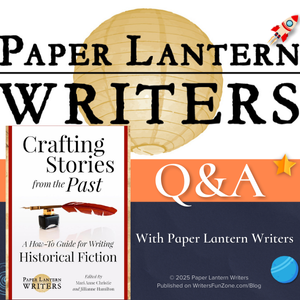 Please welcome Paper Lantern Writers to our Featured Author Q&A series at Writer’s Fun Zone. Enjoy!
Please welcome Paper Lantern Writers to our Featured Author Q&A series at Writer’s Fun Zone. Enjoy!
***
If you’d like to be considered for an interview, check out our guidelines here.
***
About Paper Lantern WritersOn to Our Interview!Q. Tell us who you are and what inspires you to write.
We are the Paper Lantern Writers, an author collective focused on historical fiction of all eras. From the medieval world to WWII (and beyond), in locales around the world, from romantic to tragic, and back again, our books will take you on the journeys of a lifetime.
There’s a story to be told everywhere you look and we’d love to be your tour guides.
Paper Lantern Writers include: Ana Brazil, Edie Cay, C.V. Lee, Kathryn Pritchett, Linda Ulleseit, Anne M. Beggs, Mari Christie, Rebecca D’Harlingue, Jillianne Hamilton, Jonathan Posner, Alina Rubin, Vanitha Sankaran
A. We’re the Paper Lantern Writers (PLW), a dozen award-winning historical fiction writers banding together to cross-promote our books and short stories.
Writing and promoting historical fiction is an exhilarating, maddening, terrifying, mysterious, wretched, and miraculous experience, but it’s much easier when you have a fellow writer to help you out.
We’re inspired to write because the past intrigues us, and we enjoy making sense out of it by crafting emotionally-rich, adventurous, fascinating characters and stories.
Q. How did you get to this place in your life? Share your story!A. At the 2019 Historical Novel Society Conference, Linda Ulleseit, Ana Brazil, and Kathryn Pritchett attended a panel about the challenges of promotion, and quickly realized that working as a group to promote each others’ books made a lot of sense.
Paper Lantern Writers started with five Northern California authors and expanded internationally. We published a historical fiction anthology–UNLOCKED–in 2022, and enjoyed it so much that we published two more: BENEATH A MIDWINTER MOON (2023) and DESTINY COMES DUE (2024). We decided to share our hard-earned writing knowledge with CRAFTING STORIES FROM THE PAST: A HOW-TO GUIDE FOR WRITING HISTORICAL FICTION.
Q. What are you most passionate about?A. Each of us are passionate about telling stories set in the past, but after that, our passions vary.
Our writing dips into so many historical genres: mystery and romance; family heritage stories; women’s fiction; adventure, and generational saga.
It’s a lot of fun to read the variety within our group!
Q. Can you tell us a little bit about your writing process, routine, and/or rituals around your writing?A. Although we created PLW to promote our historical fiction–and decidedly not to critique each other’s writing–over the years we do discuss our latest works, cheer each other on, and celebrate each win.
Every month we host a write-in for our members to share space via Zoom. It’s a great way for us to announce intentions and projects, and get the job done!
Q. What are a few challenges you faced in creating, marketing, or publishing your creative work? And your solutions to them.A. All of our members are self, hybrid, or indie published, and–as every writer learns–the biggest challenge to finding readers is being seen.
There are a lot of great books coming out every week, and to keep our books from getting lost, we work together to cross-promote our fiction.
We’ve got our own Paper Lantern Writers website where we blog twice-a-week about reading and writing historical fiction. We host a Facebook Group–Paper Lantern Readers–that brings together readers and writers from around the world, and we have a monthly newsletter to share our personal stories with readers.
We’re also active on Instagram, have spoken at numerous historical fiction events, and love to share our books at book festivals.
We celebrate each other’s publications through our individual newsletters, substacks, and social media accounts.
Q. What do you wish you had known before you started writing fiction?A. You’ll have to read our CRAFTING STORIES FROM THE PAST: A HOW-TO GUIDE FOR WRITING HISTORICAL FICTION to find that out!
Q. What’s next for you in your creative work?A. Our weekly blogs are highly creative and each month we explore a topic we’re curious about.
In addition to our non-fiction craft book, we are publishing another anthology in November 2025.
Q. Is there anything else you wished I’d asked? Please share!A. All our information is on our website and social media. Join us there!
Crafting Stories From the Past by Paper Lantern Writers
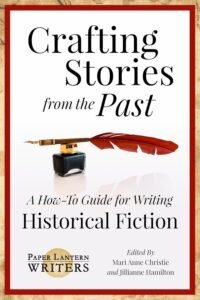 Are you fascinated by writing in the past? Do you wonder how to bring antiquity to life? To meet the weighty challenge of writing historical fiction and enliven your plot, characters, setting, and story, pick up Crafting Stories from the Past from the Paper Lantern Writers. No matter how, when, or where in the historical world your imagination takes you, this guide can help.
Are you fascinated by writing in the past? Do you wonder how to bring antiquity to life? To meet the weighty challenge of writing historical fiction and enliven your plot, characters, setting, and story, pick up Crafting Stories from the Past from the Paper Lantern Writers. No matter how, when, or where in the historical world your imagination takes you, this guide can help.
Paper Lantern Writers, an award-winning international collective of historical fiction novelists, developed and curated this compendium of insightful how-to articles from genre experts, twenty-four chapters of hard-earned wisdom from working authors. From deciding when and what to research to building a historical world, we bring you practical advice, authorial insights, and helpful guidance to make your writing process easier, start to finish.
These incisive how-tos are followed by research and writing resources culled from the authors’ own shelves: the places these professionals go to research and write their own books. Whether you are just starting your path into the past or are a seasoned multi-book author, we have tips, tricks, ideas, and resources you can use at every stage of your writing journey.
Connect with Paper Lantern WritersSite Link www.PaperLanternWriters.com
Facebook https://www.facebook.com/PaperLanternWriters
Instagram https://www.instagram.com/paperlanternwriters
The post Q&A with Paper Lantern Writers appeared first on Writer's Fun Zone.

